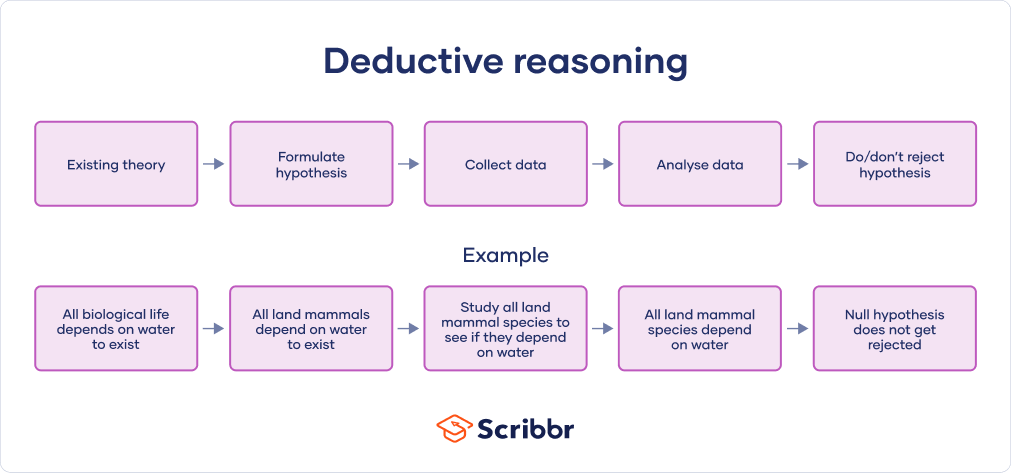What Is Deductive Reasoning? | Explanation & Examples
Deductive reasoning is a logical approach where you progress from general ideas to specific conclusions. It’s often contrasted with inductive reasoning, where you start with specific observations and form general conclusions.
Deductive reasoning is also called deductive logic or top-down reasoning.
What is deductive reasoning?
In deductive reasoning, you’ll often make an argument for a certain idea. You make an inference, or come to a conclusion, by applying different premises.
A premise is a generally accepted idea, fact, or rule, and it’s a statement that lays the groundwork for a theory or general idea. Conclusions are statements supported by premises.
Deductive logic arguments
In a simple deductive logic argument, you’ll often begin with a premise, and add another premise. Then, you form a conclusion based on these two premises. This format is called ‘premise-premise-conclusion’.
| Premise | All insects have exactly six legs. |
|---|---|
| Premise | Spiders have eight legs. |
| Conclusion | Therefore, spiders are not insects. |
| Premise | Blue litmus paper turns red in the presence of acid. |
|---|---|
| Premise | The blue litmus paper turned red after I dropped some liquid on it. |
| Conclusion | Therefore, the liquid is acidic. |
Validity and soundness
Validity and soundness are two criteria for assessing deductive reasoning arguments.
Validity
In this context, validity is about the way the premises relate to each other and the conclusion. This is a different concept from research validity.
An argument is valid if the premises logically support and relate to the conclusion. But the premises don’t need to be true for an argument to be valid.
- If there’s a rainbow, flights get cancelled.
- There is a rainbow now.
- Therefore, flights are cancelled.
Example 2
- All chili peppers are spicy.
- Tomatoes are a chili pepper.
- Therefore, tomatoes are spicy.
Both of these arguments are valid. Even though the premises are completely made up, they relate to each other in a way where you can justifiably infer the conclusion.
In an invalid argument, your premises can be true but that doesn’t guarantee a true conclusion. Your conclusion may inadvertently be true, but your argument can still be invalid because your conclusion doesn’t logically follow from the relationship between the statements.
- All leopards have spots.
- My pet gecko has spots.
- Therefore, my pet gecko is a leopard.
Example 2
- All US presidents live in the White House.
- Barack Obama lived in the White House.
- Therefore, Barack Obama was a US president.
Both of these are invalid because the truth of the premises doesn’t necessarily lead you to a true conclusion. You end up with a correct conclusion in the second example, but both arguments take the same invalid format.
Soundness
An argument is sound only if it’s valid and the premises are true. All invalid arguments are unsound.
If you begin with true premises and a valid argument, you’re bound to come to a true conclusion.
- Flights get cancelled when there are extreme weather conditions.
- There are extreme weather conditions right now.
- Therefore, flights are cancelled.
Example 2
- All fruits are grown from flowers and contain seeds.
- Tomatoes are grown from flowers and contain seeds.
- Therefore, tomatoes are fruits.
Deductive reasoning in research
Deductive reasoning is commonly used in scientific research, and it’s especially associated with quantitative research.
In research, you might have come across something called the hypothetico-deductive method. It’s the scientific method of testing hypotheses to check whether your predictions are substantiated by real-world data.
This method is used for academic as well as non-academic research.
Here are the general steps for deductive research:
- Select a research problem and create a problem statement.
- Develop falsifiable hypotheses.
- Collect your data with appropriate measures.
- Analyse and test your data.
- Decide whether to reject your null hypothesis.
Importantly, your hypotheses should be falsifiable. If they aren’t, you won’t be able to determine whether your results support them or not.
You formulate your main hypothesis: Switching to a four-day work week will improve employee well-being. Your null hypothesis states that there’ll be no difference in employee well-being before and after the change.
You collect data on employee well-being through quantitative surveys on a monthly basis before and after the change. When analysing the data, you note a 25% increase in employee well-being after the change in work week.
Using a statistical test, you find that your results show statistical significance. You reject your null hypothesis and conclude that your results support your main hypothesis.
Deductive vs inductive reasoning
Deductive reasoning is a top-down approach, while inductive reasoning is a bottom-up approach.
In deductive reasoning, you start with general ideas and work toward specific conclusions through inferences. Based on theories, you form a hypothesis. Using empirical observations, you test that hypothesis using inferential statistics and form a conclusion.
Inductive reasoning is also called a hypothesis-generating approach, because you start with specific observations and build toward a theory. It’s an exploratory method that’s often applied before deductive research.
In practice, most research projects involve both inductive and deductive methods.
Frequently asked questions about deductive reasoning
Cite this Scribbr article
If you want to cite this source, you can copy and paste the citation or click the ‘Cite this Scribbr article’ button to automatically add the citation to our free Reference Generator.
Bhandari, P. (2022, December 05). What Is Deductive Reasoning? | Explanation & Examples. Scribbr. Retrieved 2 July 2025, from https://www.scribbr.co.uk/research-methods/deductive-reasoning-types/

